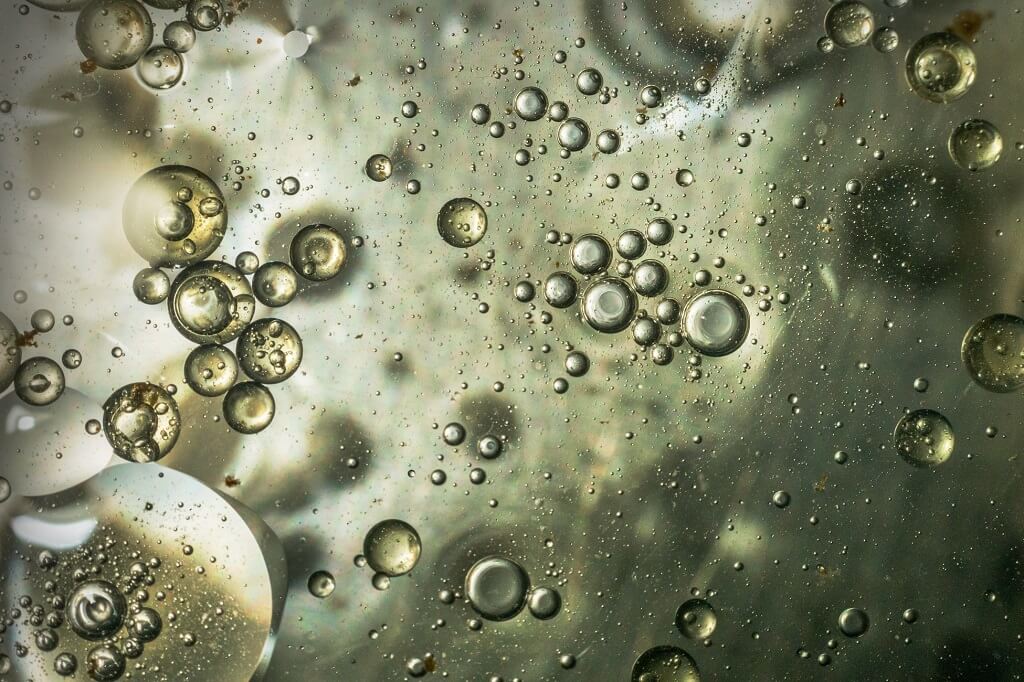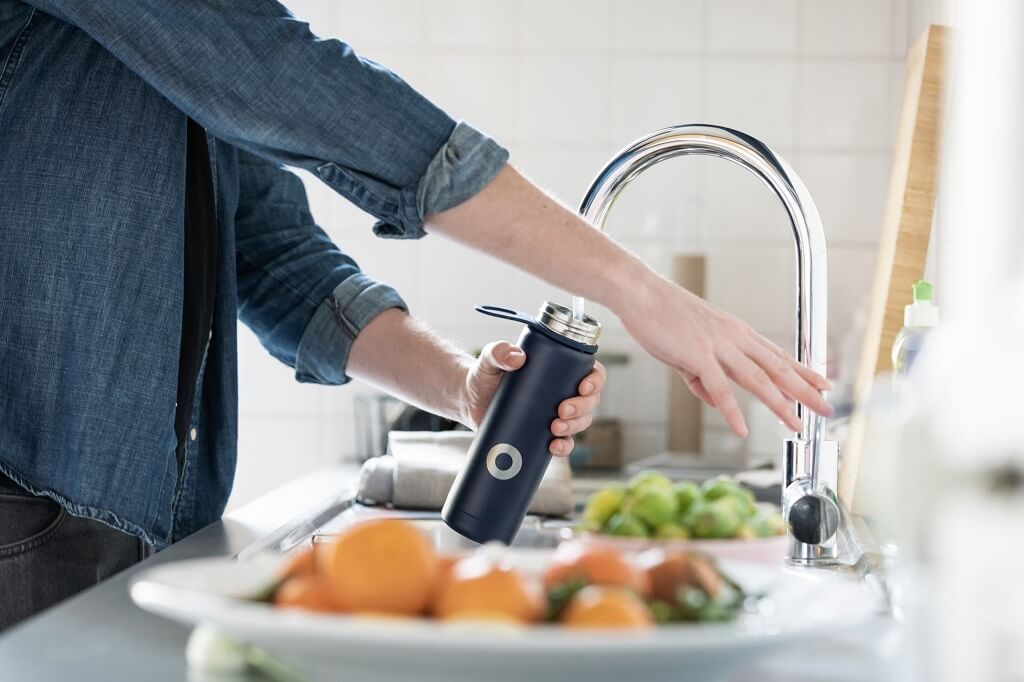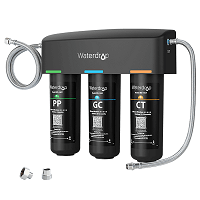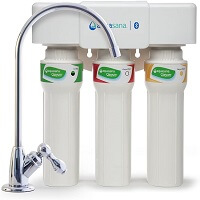Are you in the market for an under-counter multi-stage filter for your home? Then, this post is for you. We have researched and identified the best options you should consider, emphasizing the various filtration stages and processes, costs, upsides, and downsides of each recommendation.
So, without wasting time, let’s get to it.
You pay more for more stages.
It is pretty standard: how much you pay for a filtration system depends on the number of filtration stages. The more the stages, the number of components involved, including fittings, cartridges, housings, and pipes. That is why you pay more for an advanced filter system than the basic models.
Furthermore, more filtration stages translate finer filters. For instance, you can have a 0.04-micron filter in a two-stage under the sink system and a 0.005-micron filter in a five-stage reverse osmosis system. The latter filtration system is finer and will eliminate more impurities, including those with smaller molecules.
In essence, what you get depends on how much you pay. That said, there are excellent multi-stage filters out there at reasonable prices. Some even come with a free installation service. For example, $300 can get you a three-stage filter, and you get a free installation service and a free designer complementary tap to make the unit whole. However, you may need an experienced technician to install the entire unit, and that takes between 30 minutes and 1 hour, after which you can enjoy fresh and clean water.
But that is only the upfront cost. In addition, you should factor in long-term costs for maintenance and replacement parts. For instance, you need to replace the filter cartridges of the system every 12 months to ensure optimal performance. While the housings, pipes, and fittings may also require replacements, the overall warranty usually covers them. That is why you must ensure you get a warranty that covers replacements and future repairs when buying your unit.
There are various water purification stages.
With filtration stages and water filter costs out of the way, let’s discuss the various stages of filtration. The filtration stages in a unit determine how contaminants are removed from the water. You can use this information to ensure you get the best value for your money.
There are three primary filtration stages;
- Stage 1 removes sediments, dust, and dirt.
- Stage 2 removes heavy metals, chlorine, and other substances.
- Stage 3 removes bad taste and bitterness.
The first stage is where the system removes sediments and dirt. It is the first stage because these contaminants are the largest and easiest to remove. Basic filters are effective against sediments, dirt, sand, and other causes of turbidity. It also improves the appearance and taste of water, making the job much easier for the subsequent stages of filtration.
In a three-stage filtration system, the second filtration stage is where contaminants like heavy metals, chlorine, and others leave the mix. In more sophisticated systems like five-stage reverse osmosis systems, chlorine removal takes a separate stage because it protects the ultrafine membrane filter required for the subsequent stages.
The middle or second stage is where the main purification happens. The elimination of the small harmful particles takes place in this stage, including zinc, mercury, lead, iron, copper, cadmium, aluminum, and chlorine. Some filters are also effective against Volatile Organic Compounds (VOCs) and microorganisms like Cryptosporidium and E. coli, thanks to the 0.005-micron rated ultrafine membrane.

The last stage takes care of the taste and smell. After all, what is filtered water without a great taste and refreshing feeling? The last stage of filtration removes unfavorable odors and tastes, ensuring that your filtered water is safe, healthy, and tasty.
The filtration process is quite simple and direct. Once the sediments and dirt are out of the line, the focus shifts to chlorine and heavy metals. Then, the odor and taste aspects are sorted, and you have quality filtered water coming out of your filtration system’s faucet.
Filters’ output and lifespan.
If you eventually get a decent $300 multi-stage under-the-sink filtration system that comes with free installation, parts, and labor, how many years can you get out of it? That is another important consideration when buying a filtration unit.
Fortunately, you can assess how long or durable a filtration unit will be before purchase. Start by checking where the parts – tubes, fittings, and housings – were made. A durable unit will have strong enough parts to withstand high pressure, even with continuous use. We recommend filtration systems with parts made in Australia, UK, and the USA. Locally-assembled units also tend to have little or no issues with compatibility.
The next port of call is the output of the filtration unit. You need to be sure the unit has an output that can serve your entire family, even during peak use like family gatherings, post-breakfast or dinner, and similar situations. Averagely, we drink two liters of water daily. If a family consists of four people, the daily water requirement would be 8 liters. That, alongside the water for other domestic uses like washing, bathing, and cooking, can make it up to 50 liters daily.
The good news is that most under-counter multi-stage filters out there have an output of 100+ liters of filtered water daily. That will be sufficient for small families and even mid-sized families with minimal water usage.
Recommended Under Counter Multi-Stage Filter Systems
Waterdrop Triple-Stage Water Filtration System
Unlike single-filter filtration systems, this under-counter filter from Waterdrop is effective against more contaminants. It is equipped with more filters, all with longer lifespans. There are three filters in this filtration system, each delivering pure, filtered, and refreshing water at all times. The PP cotton is effective against rust, sand, large particles, and other contaminants. The granular activated carbon filter is effective against bad odor, taste, and chlorine. The third filter -the natural carbon block and KDF filter – ensures pollutants do not accumulate to distort the taste of the filtered water.
Aquassana AQ-5300+ Triple-Stage Kitchen Counter Filtration
With this system, you get 0.5 gallons of filtered water every minute. If you want instant purified water on request, this filter system performs better than traditional drip filters. It reduces up to 99% of over 70 contaminants in tap water while restoring beneficial minerals that improve health. However, this system is not effective against Total Dissolved Solids.
Finally…
We are confident this detailed guide into multi-stage under-counter filtration systems has equipped you with all the information you need to make the right choice when next you are shopping for a suitable filtration system for your home.
Remember, filtered water is the best drinking water for you and your family.





